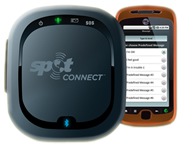We’ve compiled some useful tips for living in Mexico from our personal experiences starting with;
Getting Money
 Most Mexican Banks have cash machines outside. For example, there is an HSBC bank in Lazaro Cardenas, close to the town of San Quintín. Their ATM machines have both Spanish and English text. You are charged a flat rate of approximately 33 pesos (about $1.80) on the Mexican side and $2.50 by your U.S. bank. As the fee is flat-rate, you pay the same to withdraw $10 as $365. We suggest you withdraw the maximum of $7000 Pesos (about $365) if you will be staying here long enough to use it. Just like the U.S. and Canada, be sure to get your cash during business hours and not late at night. And surprise, you can elect to get U.S. Dollars instead of Pesos at most ATMs.
Most Mexican Banks have cash machines outside. For example, there is an HSBC bank in Lazaro Cardenas, close to the town of San Quintín. Their ATM machines have both Spanish and English text. You are charged a flat rate of approximately 33 pesos (about $1.80) on the Mexican side and $2.50 by your U.S. bank. As the fee is flat-rate, you pay the same to withdraw $10 as $365. We suggest you withdraw the maximum of $7000 Pesos (about $365) if you will be staying here long enough to use it. Just like the U.S. and Canada, be sure to get your cash during business hours and not late at night. And surprise, you can elect to get U.S. Dollars instead of Pesos at most ATMs.
Eating Out
 Many of the local restaurants offer great food at value prices. However, always take a minute and watch them preparing food. Make sure they have water for washing the food and their hands AND that they use it.
Many of the local restaurants offer great food at value prices. However, always take a minute and watch them preparing food. Make sure they have water for washing the food and their hands AND that they use it.
Online
 Internet service is acceptable when it is up and running, which is most of the time. If you pay your bills online, we do so a day early to be sure we have a good connection. No matter where you are on the planet, Internet crime is a major factor. Additionally, note that when in Mexico, all of your searches and many times, website languages will be in Spanish. You can use a VPN (Virtual Private Network) to avoid this. A VPN is a more secure way of using open connections and can also display your Internet-related pages from a U.S. or Canadian address. This can also be a factor from services that you can only access from your native country. We use Private Internet Access for VPN services. It costs $39.95 annually or $6.95 monthly. Summing it up, using a VPN is far safer than an open connection and a VPN lets you change where you appear to be.
Internet service is acceptable when it is up and running, which is most of the time. If you pay your bills online, we do so a day early to be sure we have a good connection. No matter where you are on the planet, Internet crime is a major factor. Additionally, note that when in Mexico, all of your searches and many times, website languages will be in Spanish. You can use a VPN (Virtual Private Network) to avoid this. A VPN is a more secure way of using open connections and can also display your Internet-related pages from a U.S. or Canadian address. This can also be a factor from services that you can only access from your native country. We use Private Internet Access for VPN services. It costs $39.95 annually or $6.95 monthly. Summing it up, using a VPN is far safer than an open connection and a VPN lets you change where you appear to be.
Water
 While Fidel’s El Pabellon trucks in salt-free water and Los Olivos has informed us they will soon be installing a reverse osmosis system, be aware that salty water can cause damage to your RV’s plumbing, including significantly shortening the life of the water heater. No matter what the source of your RV’s water, whether it be from Canada, U.S. or Mexico, a few drops of chlorine in the RV’s water tank to purify the water is a good idea. Filtering any water for your RV is also advised.
While Fidel’s El Pabellon trucks in salt-free water and Los Olivos has informed us they will soon be installing a reverse osmosis system, be aware that salty water can cause damage to your RV’s plumbing, including significantly shortening the life of the water heater. No matter what the source of your RV’s water, whether it be from Canada, U.S. or Mexico, a few drops of chlorine in the RV’s water tank to purify the water is a good idea. Filtering any water for your RV is also advised.
Weather
 For those of you who have stayed at the US Southern LTVAs, you will be happy to know that there is far less wind here than there is in the desert. And though you won’t be cleaning up as much dust as in the desert, you’ll be sweeping out plenty of beach sand:). Also note that like about anywhere on the Pacific Coast, you will have many cloudy mornings and more cloudy days than in the desert LTVAs.
For those of you who have stayed at the US Southern LTVAs, you will be happy to know that there is far less wind here than there is in the desert. And though you won’t be cleaning up as much dust as in the desert, you’ll be sweeping out plenty of beach sand:). Also note that like about anywhere on the Pacific Coast, you will have many cloudy mornings and more cloudy days than in the desert LTVAs.
Baja Rumors
 The worst thing about the Internet is that it gave a voice to people who perhaps shouldn’t have one. Also, people tend to believe the first thing they read without further investigation or thought about the source of the information and whether or not it’s reliable.
The worst thing about the Internet is that it gave a voice to people who perhaps shouldn’t have one. Also, people tend to believe the first thing they read without further investigation or thought about the source of the information and whether or not it’s reliable.
We decided to add this section after a person with a medical degree actually asserted with full confidence that Mexico wasn’t right for him because, as he stated, his vehicle wasn’t 5 years old so he couldn’t bring it down here. When asked where in God’s name he got that information, he answered, on the Internet! Worse yet, even after discussing our years of experience with buying and parking brand-new vehicles down in Baja and crossing the border at least 100 times with these vehicles and never having a problem, he still continued to believe the information he read on the Internet.
Another source, perhaps the largest source of misinformation, are Facebook, message boards and comment sections where anyone is allowed to make un-moderated comments. We reviewed a popular blog about Baja where someone posted a legitimate question concerning robberies on the road between San Quintín and San Vicente and asked whether anyone had knowledge about this. Instead of answering the question, the replies were about how to combat would-be robbers with bug spray, hair spray or pepper spray. If there was a legitimate problem with robberies, there was no mention of it.
As for Facebook, we have a rule: never use it as a source for reliable information! Facebook simply makes it too easy to publish and spread rumors, in fact it promotes it with their policies getting users on a quest for likes or to be trending without any thought of the consequences. Here is a simple check. See who is publishing a message board hosted on Facebook. Go to their personal page and see what they are re-posting and from where. Their page and re-posts will generally show their true colors.
We recommend doing research in places like government websites, legitimate news agencies and websites, not message boards, before reaching any conclusions. Having preconceived fears about Baja then reading some fly-by-night blog or message board to reinforce those fears, then communicating that misinformation to others, benefits no-one. Baja is not for everyone. If you’re afraid to come to Baja, just admit that to yourself and stay home. The danger with letting everyone comment online is just not working anymore. Worse, it can put people in danger or negatively affect their lives.
For reasonable people with real concerns, we will be happy to address those concerns honestly and point you to reputable websites with substantiated facts. We want to get you correct information, just as we have provided in this article. So please write us with your questions. Also note that we do not support a public discussion board but rather monitored comments by our members.
 Update: Keeping Baja to Themselves. We just got some insight on where these crazy Baja rumors are coming from. A family of “Millennials” from Montreal Canada camped near us for a couple of days with an RV loaded with surfboards. One day we crossed paths where he was forced to say hi to us (ever notice how retirees are invisible to Millennials) and strike up a short conversation. He seemed upset when we told him we were creating the San Quintin Baja LTVA down here to get retirees to Baja.
Update: Keeping Baja to Themselves. We just got some insight on where these crazy Baja rumors are coming from. A family of “Millennials” from Montreal Canada camped near us for a couple of days with an RV loaded with surfboards. One day we crossed paths where he was forced to say hi to us (ever notice how retirees are invisible to Millennials) and strike up a short conversation. He seemed upset when we told him we were creating the San Quintin Baja LTVA down here to get retirees to Baja.
He asserted that he had been living here for 3 years and made it clear that surfers down in Baja don’t want people to know “just how safe it is” because it is “their Baja”. Just like surfers are territorial in the water, he left no doubt in my mind that he felt the same possessiveness about Baja.
We found the same sentiment with environmental campers, or at least those claiming to be environmental campers, yet ran their generators as they had no solar systems, and bird and whale watchers who want Baja to stay just the way it has been through the years. So maybe these crazy rumors are coming from groups who want to keep Baja all to themselves and have found that scare tactics work best to keep people away.
To be honest, we feel as possessive about Baja as the surfers and the environmentalists we have spoken with. After all, who wants another Southern California down here? But, we feel senior citizens would be a great asset to the area. Their environmental impact will be almost non-existent in their solar powered RVs while their financial impact at local businesses would benefit the community down here.
Our experience with the locals is that most welcome us with open arms and “Bienvenidos”!
The Flip Side
On the other side of the coin are websites that are little more than brochures for Baja. Some are simply in love with Baja and their new home. Others are selling services and products to those visiting Baja. These websites tend to leave out any negative information about Baja and what’s happening here. While we can understand that they wish to combat the rumors posed by the others as outlined above, this can be equally dangerous. Two websites that fit this profile still offer valuable information on many services you will need down in Baja. We like bajabound.com. They sell insurance online and have many how-to articles. We also like mexperience.com which is Mexico’s own award-winning (by the Mexican government) website. Please be sure to use the available information and services from these websites, but use common sense when reading any opinions.
Question our motivation at bajaltva.com as well.
We too have an interest in getting people to Baja and the Baja LTVA. But consider this. There are, according to the BLM LTVA District office managing the main Southern LTVA campgrounds, over 14,000 LTVA passes sold during the Winter season, 11,000 at Quartzsite an 3,000 at Imperial Dam. We currently have only 200 – 300 LTVA sites available. We are dealing with people that will be here a minimum of 6 months at a time and will return every year. We only allow those over 55 years old to receive the highly-discounted rates. Ask yourself what would be our motive to deceive you? Does anyone think we want people down here where WE LIVE, to come knocking on our door because we gave them bad or misleading information?
Our only goal is to provide you with the best information we can, so that you can make an educated decision as to the Baja LTVA being right for you. We know that Baja is not for everyone and we thank God for that, as we have only one kampsite available for every 56 Southern LTVAers.
Please note that both Baja LTVA Kampgrounds and Members, can and will be removed for violations of the Baja LTVA standards. But don’t worry, our standards are about honesty and consideration of your neighbors. In our day we called it common sense and common courtesy. However, this ain’t California and we will do our best to keep it that way. The Baja LTVA.
Contacting Us
While we are building the Baja LTVA, if you want information or to come down this summer, you can contact us at [email protected].









